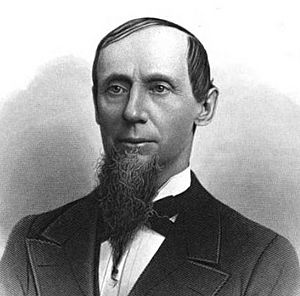Jean Brooks Greenleaf facts for kids
Jean Brooks Greenleaf (born October 1, 1832 – died March 2, 1918) was an American woman suffragist. A suffragist is someone who worked to get women the right to vote. Jean Greenleaf was one of the last people from a special group of suffragists. They were first inspired by famous leaders like Susan B. Anthony and Mary Stafford Anthony. Jean Greenleaf was the only one of these women who lived to see women in New York State finally get the right to vote. This was a big achievement in the state where she lived most of her life.
Early Life and How She Became a Suffragist
Jean F. Brooks was born in Bernardston, Massachusetts, on October 1, 1832. Her parents were Dr. John Brooks and Mary Bascom Brooks. Her father had very strong and modern ideas for his time. He believed his daughters should be trained to be useful and independent. He also encouraged them to think for themselves about important topics. Her mother was good at taking care of their home. Even though she had a disability, she actively helped people who were not as lucky as she was. Jean was the youngest of six children who lived to be old.
Jean's school days were short. She went to public schools and an academy in her hometown. She also spent two terms at Melrose Seminary in West Brattleboro, Vermont. When she was seventeen, her mother's disability meant Jean had to stop school. For the next three years, until she got married, she took on many of the duties in her father's house.
Her interest in women's rights started early. She often heard her widowed aunt, Mrs. Willard, complain strongly. Her aunt was upset about paying taxes on property she had earned herself. She felt it was unfair because she had no say in how the government was run, as she couldn't vote. Meanwhile, a man in the neighborhood who drank too much and owned no property could vote. He could even vote against what her aunt (and his own wife and daughters) thought was best for the community. This unfairness made a big impression on Jean.
Working for Women's Right to Vote
In 1862, Jean married Halbert S. Greenleaf. Her life was mostly spent quietly at home after that. Her husband served his country in the military and in government. He was a commander in the American Civil War for the Union side. He fully supported his wife's views on women getting the right to vote.
After the Civil War, they lived in Louisiana for a few years. But for over fifty years, Rochester, New York was their home. They also spent some time in Washington, D.C. when her husband was a member of the United States Congress. Jean Greenleaf was also a director of the Sargent & Greenleaf Company. For some years, she was a trustee at St. Lawrence University.
Jean Greenleaf was a very strong supporter of women's right to vote. She was happy to make any sacrifices needed for this important cause. She was one of the first members of the Woman's Political Club of Rochester. She served as its president and later became its honorary president for twenty years. In December 1890, she was chosen to be the president of the New York State Woman's Suffrage Association. She held this important role until 1896.
Under her leadership, a petition was presented to the state constitutional convention in 1894. This petition asked for women's voting rights to be included in the state's constitution. In 1893, Jean Greenleaf even ran as a candidate to be a delegate at that convention. She received many votes. At the state suffrage convention in November 1896, held in Rochester, Jean Greenleaf decided not to run for re-election. Mariana Wright Chapman was then chosen to take her place. Jean Greenleaf was appointed as a special delegate to the annual meeting of the State Grange, another important organization.
Later Life and Legacy
Jean Brooks Greenleaf passed away at her home on March 2, 1918. She was buried in Rochester's Mount Hope Cemetery. She left many gifts in her will, and many people benefited from her estate. Her dedication helped pave the way for women to gain the right to vote in New York and across the United States.



